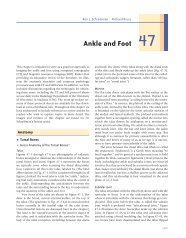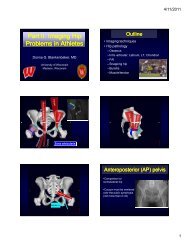CT Arthrography (CTR)
CT Arthrography (CTR)
CT Arthrography (CTR)
Create successful ePaper yourself
Turn your PDF publications into a flip-book with our unique Google optimized e-Paper software.
targeting the radial surface of the distal ulna, about 1 cm proximal to the wrist. All wrist<br />
injections can be accomplished with a short 1.5 inch needle.<br />
Unlike other major joints, evaluation of the wrist under fluoroscopy at the time of<br />
injection is frequently very illuminating. Evaluating ligament tears as the contrast first<br />
passes through them is much easier than after two or all three joint spaces (distal<br />
radioulnar, radiocarpal, and midcarpal) are full of contrast. If one has the capability of<br />
saving images from fluoroscopy, doing so can be especially beneficial in discussions with<br />
a knowledgeable hand/wrist surgeon. A variety of passive and active range of motion<br />
movements may augment the likelihood of detecting small perforations and tears.<br />
After the injection, the wrist should be placed over the head for <strong>CT</strong> imaging if at all<br />
possible.<br />
Findings and Indications: Sports related cartilage loss is not a big issue for the wrist and<br />
does not drive imaging. In a few instances <strong>CT</strong>R has shown excellent depiction of<br />
cartilage abnormalities of the wrist, but radiologists will seldom have the opportunity to<br />
image these abnormalities beyond radiographs.<br />
One study by De Filippo et al (Eur J Radiol 2009 in press) includes <strong>CT</strong>R of 43 wrists, 15<br />
of which had undergone prior surgery. Sensitivity and specificity were 92-94% for<br />
triangular fibrocartilage (TFC) tears; 80-100% for the scapholunate and lunatotriquetral<br />
interosseous ligaments; and 94-100% for cartilage lesions. A study by Bille and<br />
coworkers (J Hand Surg 2007; 32A:834-841) on 76 wrist <strong>CT</strong>Rs reports the following:<br />
• Central TFC tears: sensitivity 88-91%, specificity 85-95%<br />
• Peripheral TFC tears: sensitivity 30-40%, specificity 94-97%<br />
• SL ligament: sensitivity 94%, specificity 82-86%<br />
• LT Ligament: sensitivity 85-97%, specificity 79-81%<br />
• Cartilage: sensitivity 45-58%, specificity 93-97%<br />
HIP<br />
Technical Considerations: Using current technology and sequences, <strong>CT</strong>R probably<br />
outperforms MRI or even MRR in evaluating for hyaline cartilage defects in the hip. The<br />
spatial resolution and contrast of <strong>CT</strong>R cannot yet be matched by MR scanning in the hip.<br />
Now that hip arthroscopy is reaching widespread availability, evaluation of the acetabular<br />
labrum should be a goal of all these techniques. To that end, <strong>CT</strong>R imaging should<br />
include not only 3 standard orthogonal planes of reconstructions but also the “oblique<br />
sagittal/axial) plane along the axis of the femoral neck that is typically useful for MRR of<br />
the hip. Performing the coronal plane with slight obliquity to mirror the anteversion of<br />
the femoral neck is an option we don’t employ for <strong>CT</strong>R or MRR.<br />
Injecting the hip is almost always simple. One key element is to palpate the femoral<br />
vessels and stay well away from them. A 3.5 inch 22-gauge spinal needle is almost<br />
always sufficient. Some choose to send the needle straight down onto bone of the upper

















